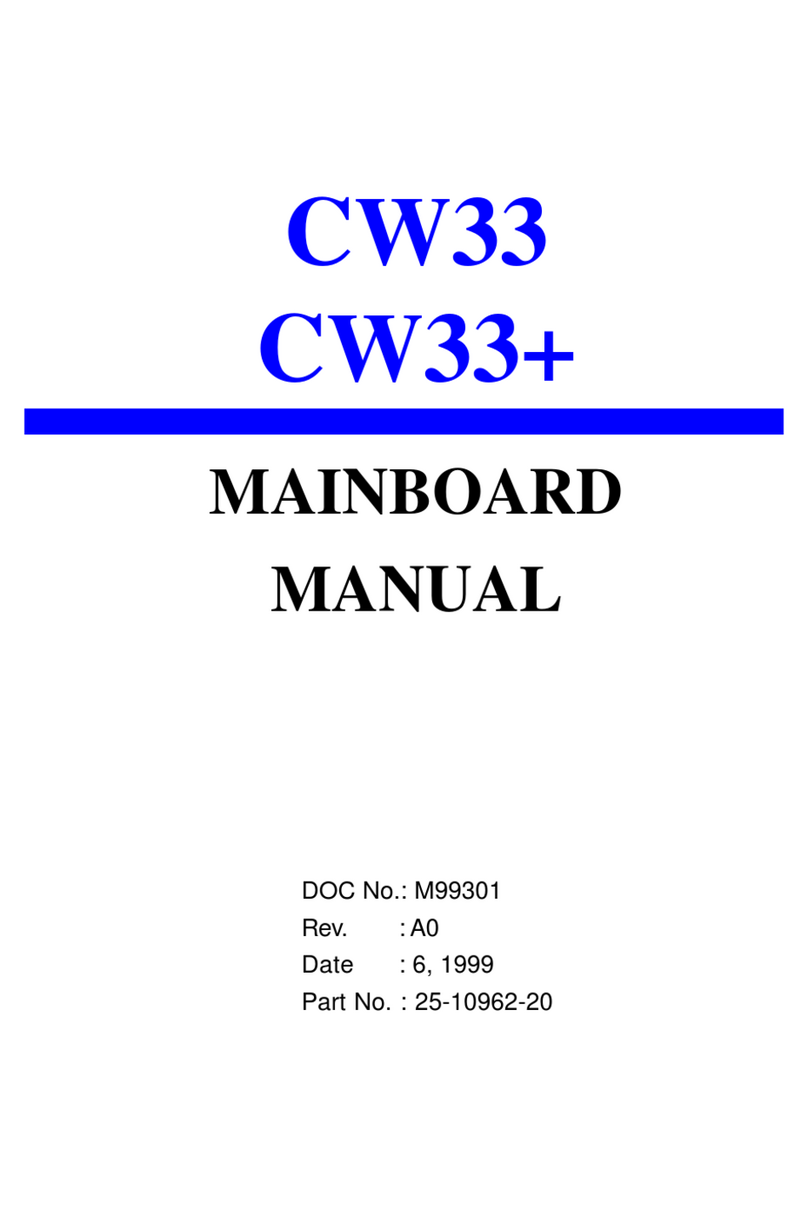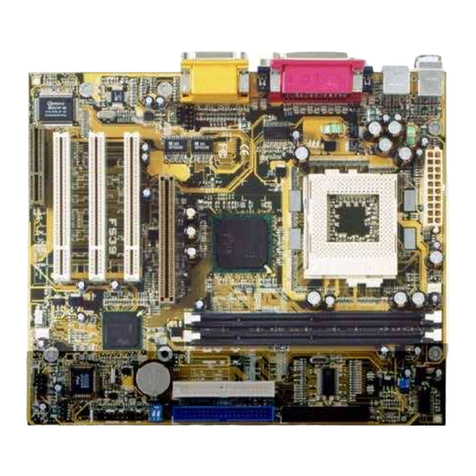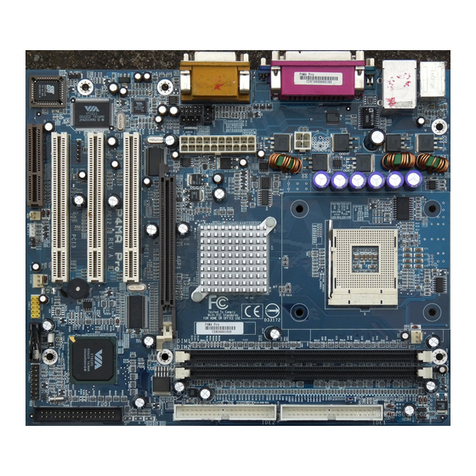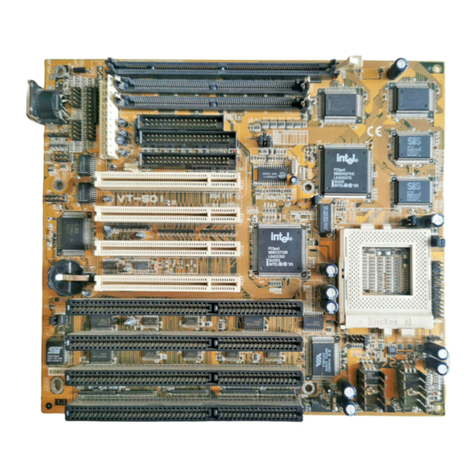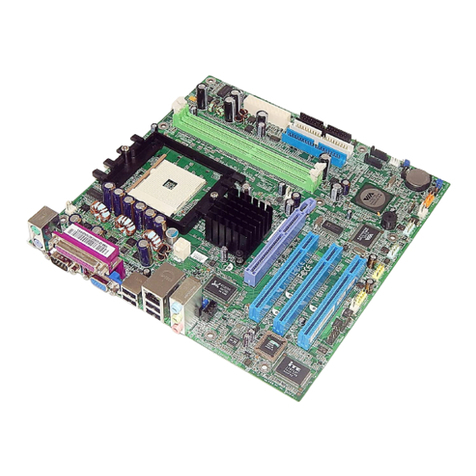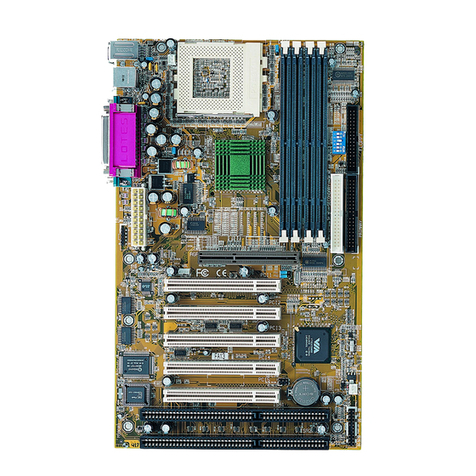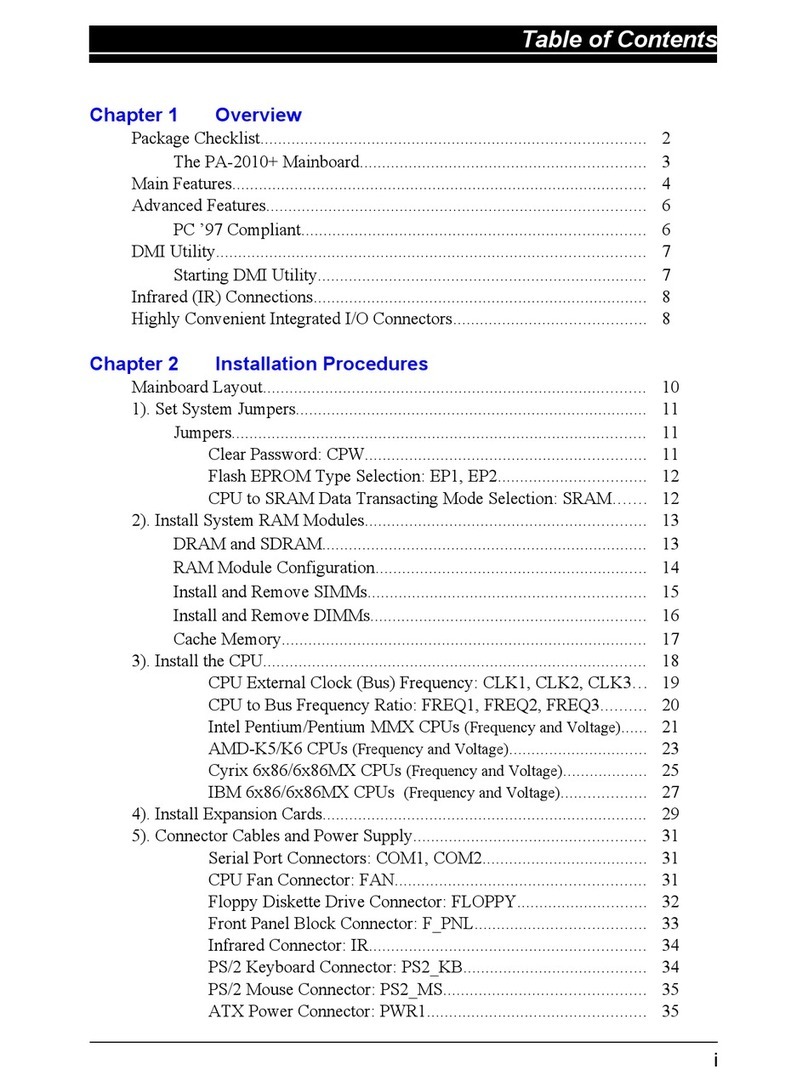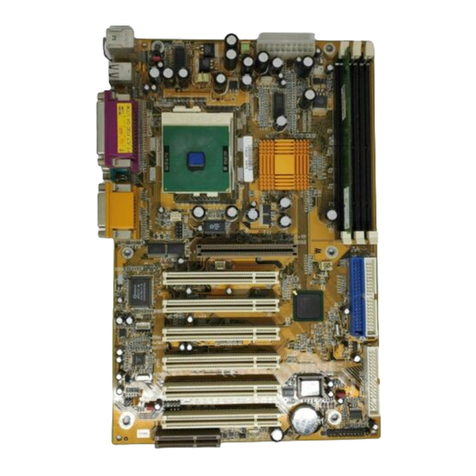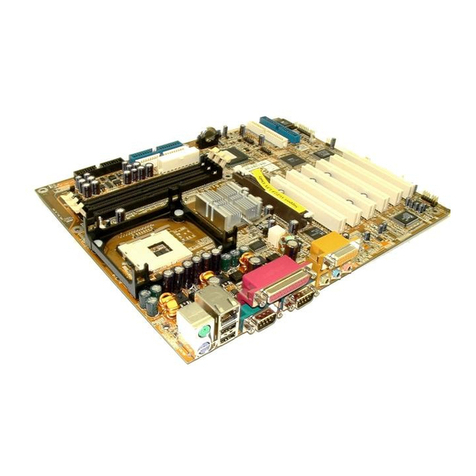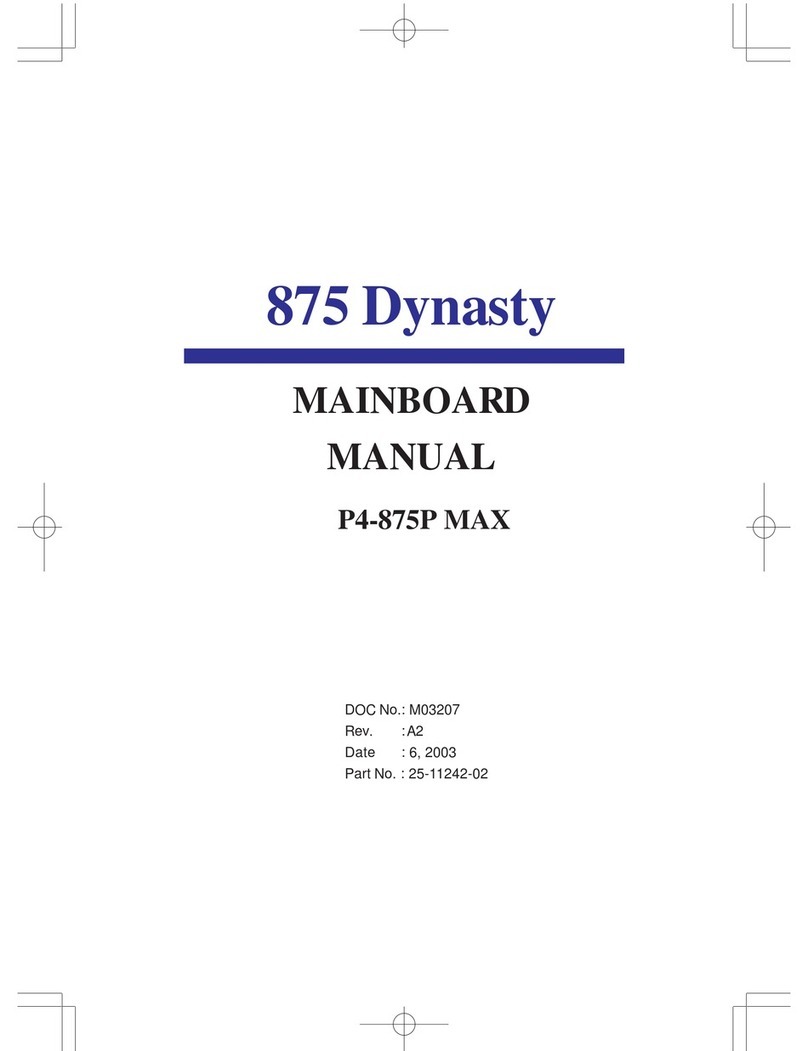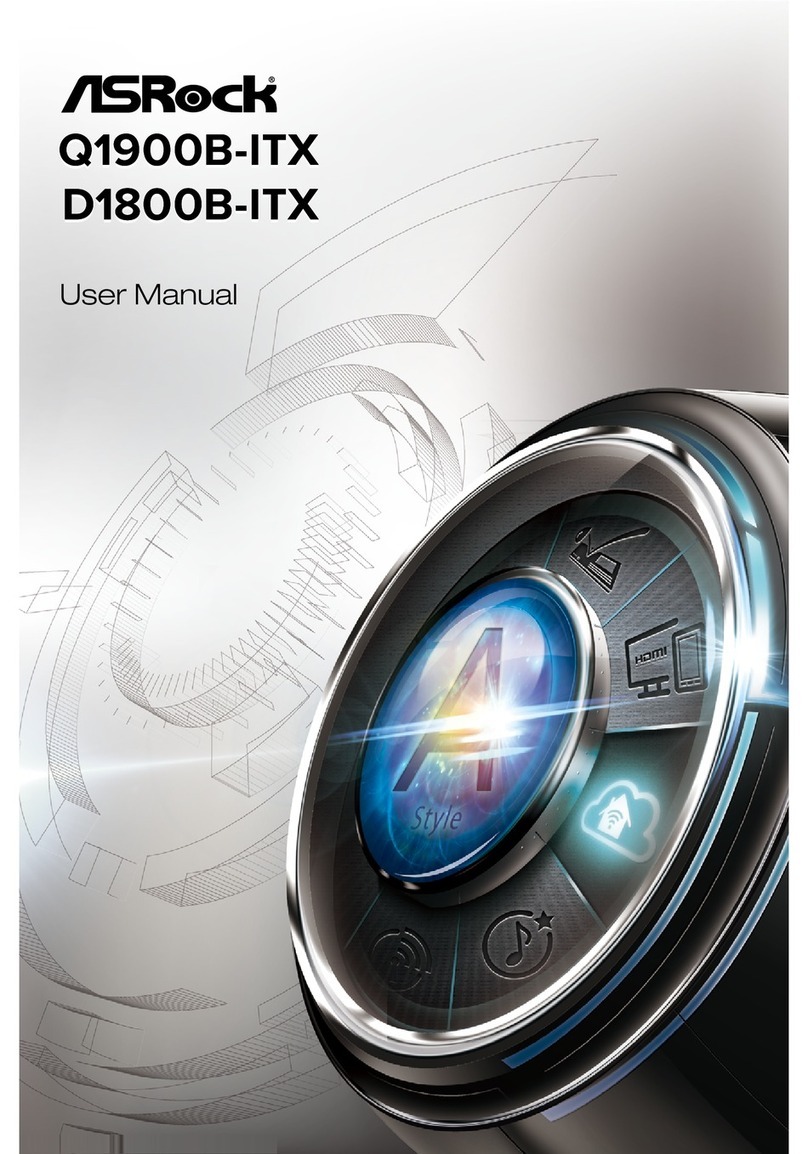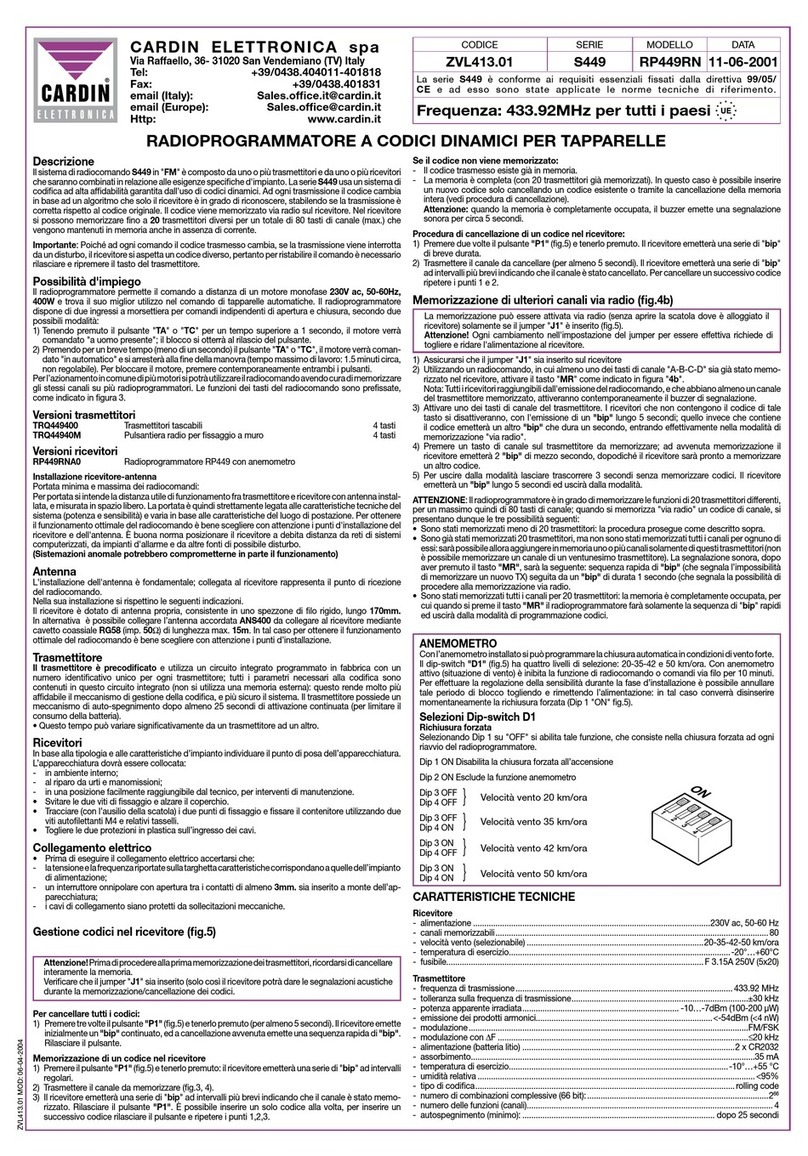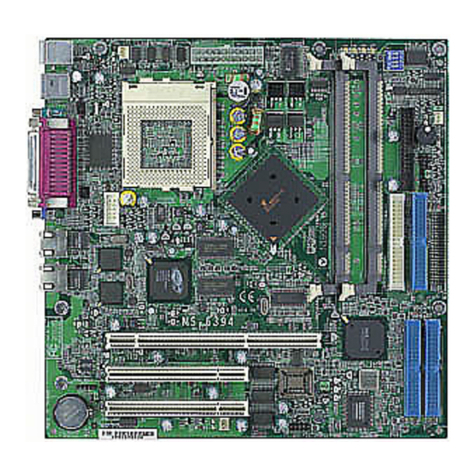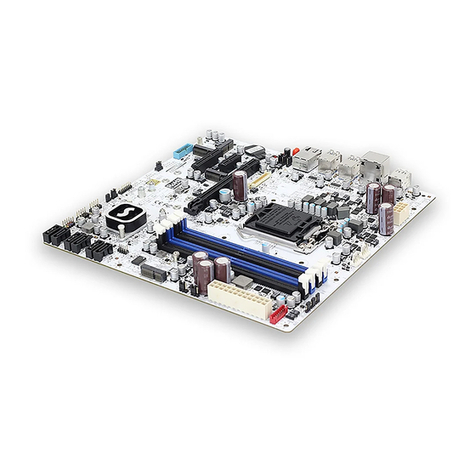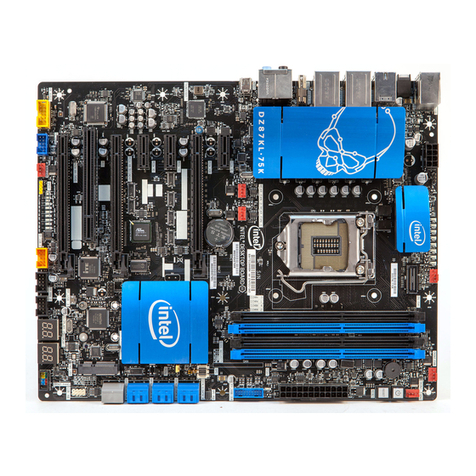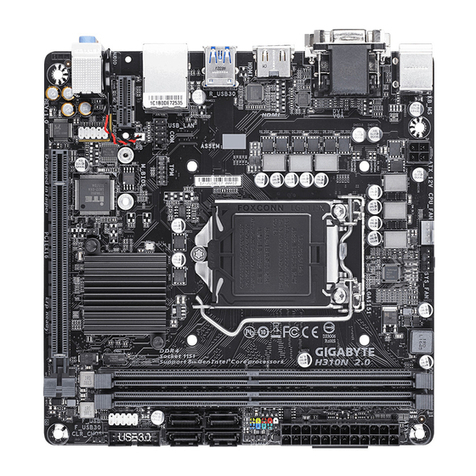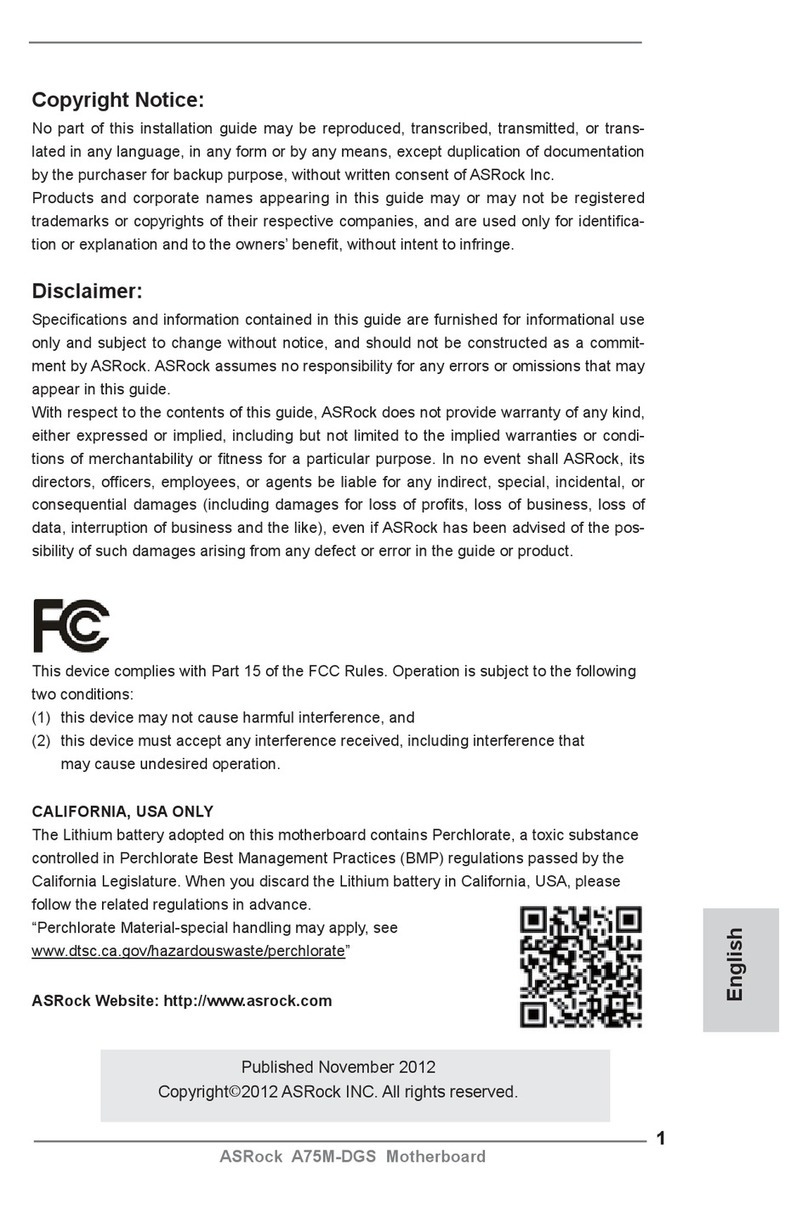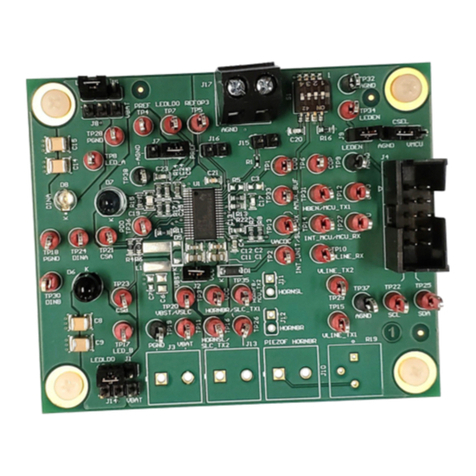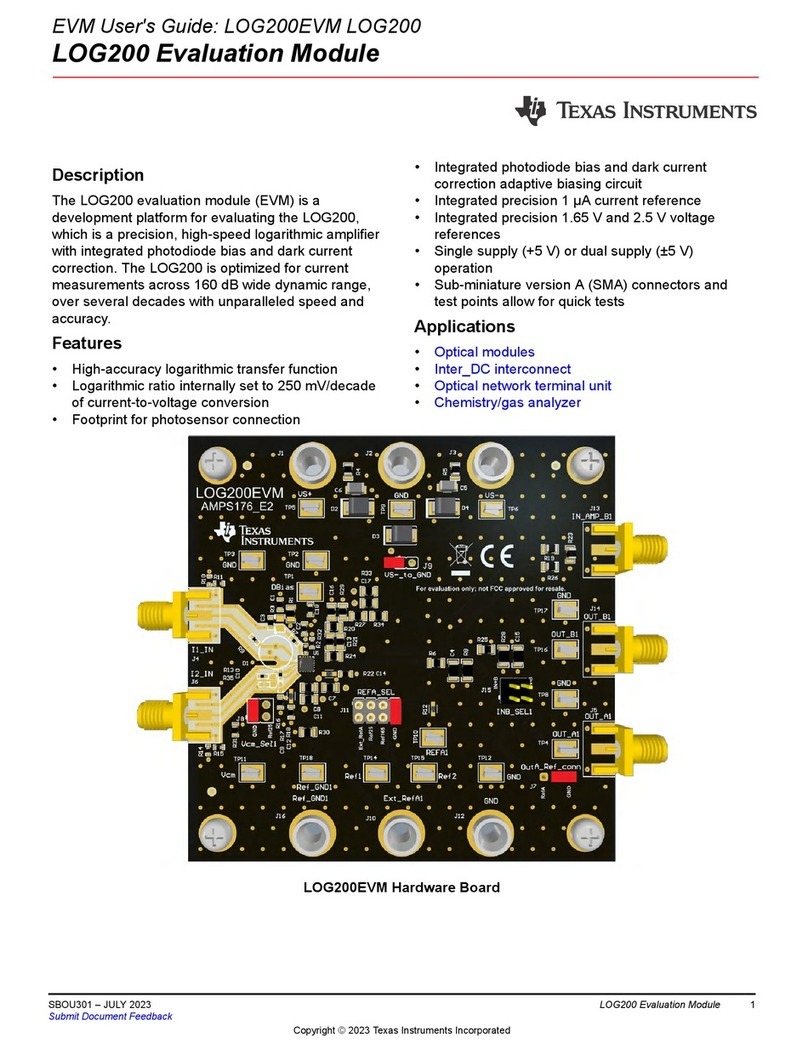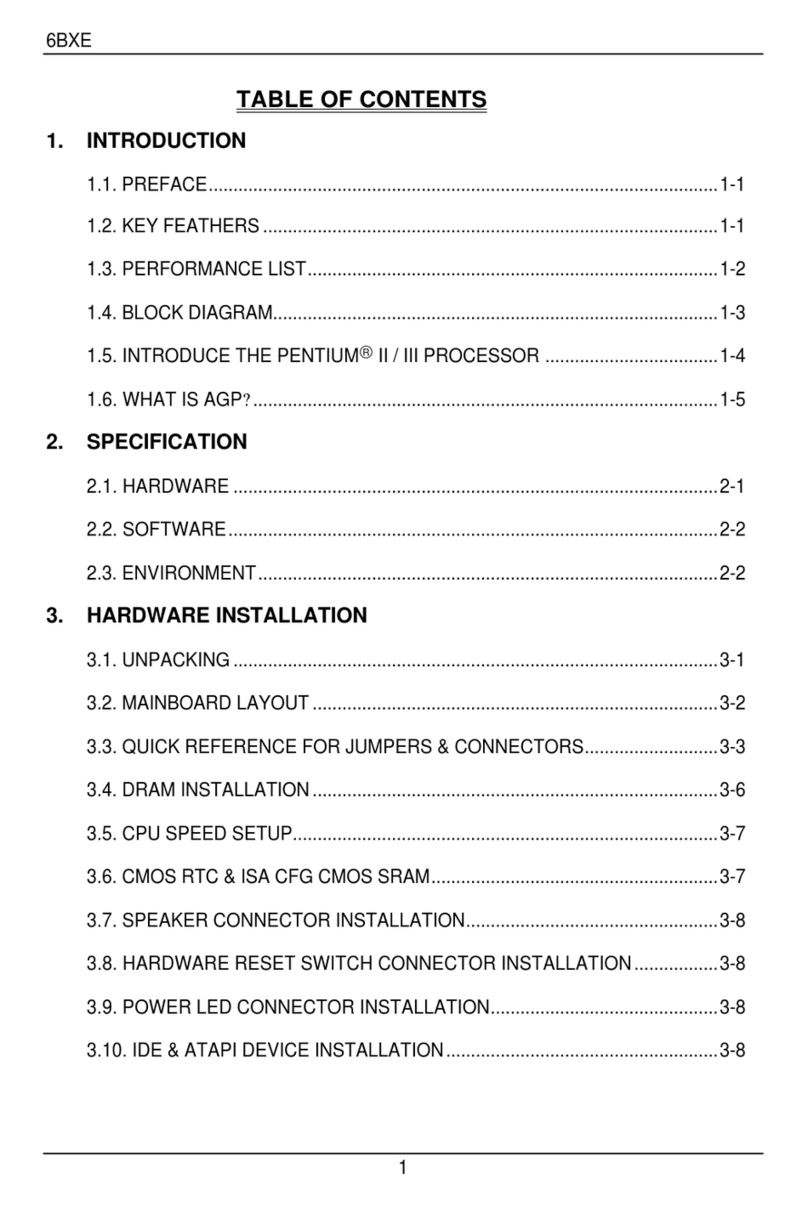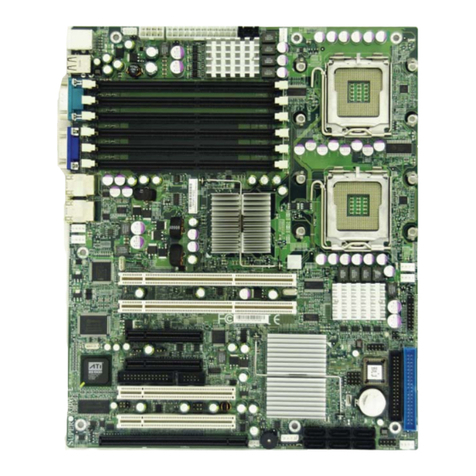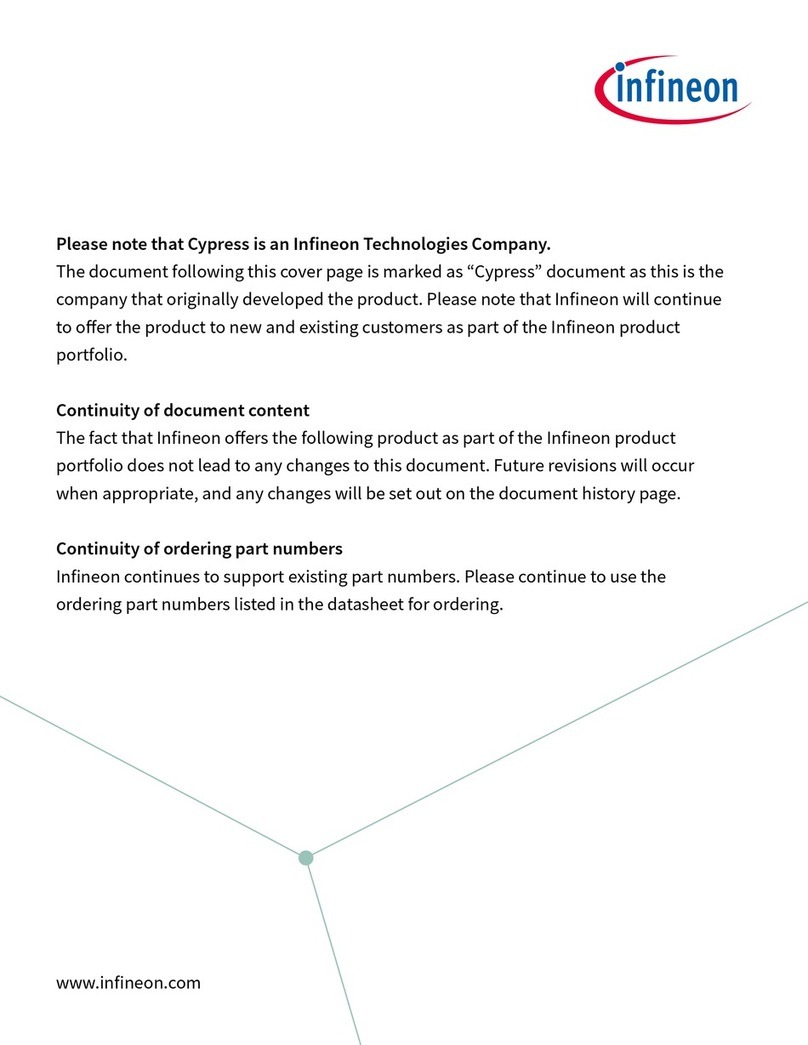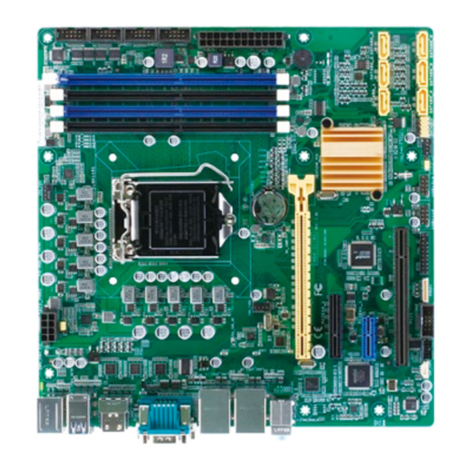FIC PA-2010 User manual

PA-2010
MAINBOARD
MANUAL
DOC No. : 15639
Rev. : A0
Date : 11, 1996
Part No. : 25-10609-00

Handling Precautions
Warning :
1. Static electricity may cause damage to the integrated circuits on the
mainboard.
Before handling any mainboard outside of its protective packaging,
ensure that there is no static electric charge in your body.
2. There is a danger of explosion if the battery is incorrectly replaced.
Replace only with the same or an equivalent type recommended by the
manufacturer.
3. Discard used batteries according to the manufacturer’s instructions.
Observe the following basic precautions when handling the mainboard or other
computer components:
■Wear a static wrist strap which fits around your wrist and is connected to a
natural earth ground.
■Touch a grounded or anti-static surface or a metal fixture such as a water
pipe.
■Avoid contacting the components on add-on cards, boards and modules and
with the “gold finger” connectors plugged into the expansion slot. It is best
to handle system components by their mounting bracket.
The above methods prevent static build-up and cause it to be discharged
properly.
Trademark
All trademarks mentioned in this manual are registered properly of the respective owners.
Copyright
This manual may not, in whole or in part, be photocopied, reproduced, transcribed,
translated, or transmitted in whatsoever form without the written the consent of the
manufacturer, except for copies retained by the purchaser for personal archival purposes.
Notice

i
Chapter 1 Overview
Main Features............................................................................................. 2
This User Manual....................................................................................... 4
Something Interesting................................................................................. 5
The BIOS Setup Utility..................................................................... 5
IRQ Functionality............................................................................. 6
DMA Channels of ISA Cards............................................................ 7
Enhanced IDE................................................................................... 7
Serial Infrared (SIR) Connections..................................................... 8
Highly Convenient Integrated I/O Connectors.................................. 9
Chapter 2 Installation Procedures
Mainboard Layout...................................................................................... 12
1). Set System Jumpers............................................................................... 13
Jumpers............................................................................................. 13
Clear Password: CPW............................................................... 14
Flash EPROM Type Selection: EP1 and EP2........................... 14
CPU to SDRAM Data Transacting Mode Selection ................. 14
2). Install System RAM Modules............................................................... 15
DRAM and SDRAM......................................................................... 15
RAM Modules Configuration........................................................... 16
Install SIMMs................................................................................... 19
Remove SIMMs................................................................................ 19
Install DIMMs................................................................................... 20
Remove DIMMs ............................................................................... 20
Cache Memory.................................................................................. 21
Onboard Cache RAM (256KB/512KB)............................................ 22
Onboard Cache RAM and SRAM Module Mixture
(512KB/1MB)................................................................................... 23
3). Install the CPUs .................................................................................... 24
CPU External Clock (Bus) Frequency:
CLK1, CLK2, and CLK3.......................................................... 25
CPU to Bus Frequency Ratio:
FREQ1 and FREQ2 .................................................................. 25
Intel Pentium CPUs................................................................... 26
Table of Contents

PA-2010 Mainboard Manual
ii
Frequency............................................................................. 26
Voltage................................................................................. 27
AMD-K5 CPUs......................................................................... 28
Frequency............................................................................. 28
Voltage................................................................................. 29
Cyrix 6x86 CPUs ...................................................................... 30
Frequency............................................................................. 30
Voltage................................................................................. 31
IBM 6x86 CPUs........................................................................ 32
Frequency............................................................................. 32
Voltage................................................................................. 33
Installation of Cyrix (or IBM) 6x86 CPU Fan .......................... 34
4). Install Expansion Cards......................................................................... 35
5). Connect Cables and Power Supply....................................................... 37
Serial Port Connectors: COM1 and COM2............................... 37
CPU Fan Connectors: FAN....................................................... 37
Floppy Diskette Drive Connector: FLOPPY............................. 38
Front Panel Block Connector: F_PNL...................................... 39
Infrared Connector: IR.............................................................. 40
PS/2 Keyboard Connector: PS2_KB......................................... 40
PS/2 Mouse Connector: PS2_MS............................................. 41
Power Connector: PWR1.......................................................... 41
Standard Power Connector: PWR2........................................... 42
IDE HDD Device Connectors:
PRIMARY and SECONDARY................................................. 43
Printer Block Connector: PRINTER......................................... 43
Remote Power Connector: RPW_CON .................................... 44
Universal Serial Bus Connectors
(Reserved For Future Upgrade)................................................. 44
Chapter 3 Award BIOS Setup
CMOS Setup Utility................................................................................... 45
Standard CMOS Setup ............................................................................... 46
BIOS Features Setup .................................................................................. 48
Chipset Features Setup............................................................................... 51
Power Management Setup.......................................................................... 55

Table of Contents
iii
PCI Configuration Setup............................................................................ 58
PnP Configuration Setup............................................................................ 60
Load BIOS Defaults................................................................................... 61
Load Setup Defaults................................................................................... 61
Supervisor/User Password.......................................................................... 61
IDE HDD Auto Detection .......................................................................... 62
Save and Exit Setup.................................................................................... 63
Exit without Saving.................................................................................... 63
Appendix A Application Note

PA-2010 Mainboard Manual
iv
This Page Intentionally Left Blank

1
Overview
The PA-2010 mainboard combines the advanced capabilities of the VIA 580VP
chipset with such leading-edge features as USB and lightning-fast SDRAM
support on an easily-expandable ATX form factor to provide the ultimate
platform for high-performance Microsoft Windows 95 multimedia systems.
This highly-flexible mainboard is designed to run a full range of Intel Pentium,
Cyrix/IBM 6x86, and AMD-K5 processors, and can be easily upgraded using its
321-pin ZIF socket and Split Voltage Regulator. The processor’s advanced
performance is complemented by a second level write back Pipeline Burst
SRAM cache of up to 1MB and main memory of up to 512MB DRAM. The
main memory is installed using the board’s four 72-pin SIMM sockets and two
168-pin DIMM sockets that accept highest performance SDRAM
Built around a versatile ATX form factor, the PA-2010 provides ample room for
expansion with its four 16-bit ISA slots and four 32-bit PCI slots. The PA-2010
also comes with a full set of I/O features onboard, including two state-of-the-art
USB connectors, two 16550A UART compatible serial ports, and one EPP/ECP
capable parallel port, which are integrated into a single dual-height rear I/O
panel for optimum ease of configuration. Other advanced features include a
high-speed PCI Bus Master Enhanced IDE controller that provides high-speed
connections to up to four IDE devices, including Hard Disk and CD-ROM
drives, an IrDA compliant serial port, and an upgradeable Plug and Play Flash
BIOS.
This chapter gives you a brief overview of the PA-2010 mainboard. In addition
to basic information on the board’s main components and features, it also
provides advice on how to upgrade and expand it. For updated BIOS, drivers, or
product release information, please visit FIC’s home page at:
http://www.fic.com.tw.
Congratulations on your decision to adopt the PA-2010 mainboard. With its
high-speed PCI local bus architecture and ultra-fast I/O connections, the PA-
2010 provides the ultimate solution for optimizing the performance of your high-
end system.
Chapter 1

PA-2010 Mainboard Manual
2
Main Features
The PA-2010 mainboard comes with the following high-performance features:
■Easy Installation
Award BIOS with support for Plug and Play, auto detection of Hard Drive
and IDE features, and MS Windows 95 compatible.
■Flexible Processor Support
The onboard 321-pin ZIF socket supports Intel Pentium (P54C) CPU speed
75/90/100/120/133/150/166/200 MHz processors/ P54CTB / P55C.
.Cyrix 6x86-P120+ (100 MHz) / 6x86-P133+ (110 MHz) / 6x86-P150+
(120 MHz) / 6x86-P166+ (133 MHz) processors / 6x86-P200+ (150 MHz)*
processors / M2 series processors.
IBM 6x86-P120+ (100 MHz) / 6x86-P133+ (110 MHz) / 6x86-P150+
(120 MHz) / 6x86-P166+ (133 MHz) processors / 6x86-P200+ (150 MHz)*
processors / M2 series processors.
.AMD K5-PR75 (75 MHz) / K5-PR90 (90 MHz) / K5-PR100 (100 MHz) /
K5-PR120 (90 MHz) / K5-PR133 (100 MHz) / K5-PR150 (105 MHz) /
K5-PR166 (116 MHz) / K5-PR200 (133 MHz) processors.
NOTE : * Support for Cyrix 6x86-P200+ and IBM 6x86-P200+ is optional.
■Leading Edge Chipset
VIA 580VP chipset, including a CPU interface controller, advanced
cache controller, integrated DRAM controller, synchronous ISA bus
controller, PCI local bus interface, integrated power management unit.
■Ultra-fast Level II Cache
Supports onboard Pipeline Burst SRAM that can be expanded to 1MB
using an optional cache module.
■Versatile Main Memory Support
Accepts up to 512MB RAM in two banks using four SIMMs of 8, 16, 32,
64, 128MB with support for FPM and EDO DRAM and two DIMMs of 8,
16, 32, 64MB with support for SDRAM and EDO DRAM.
■ISA & PCI Expansion Slots
Four 16-bit ISA and four 32-bit PCI expansion slots provide all the room
you need to install a full range of add-on cards.

Overview
3
■USB Support (Reserved for Future Upgrade)
Two Unniversal Serial Bus plug-in connectors integrated into rear I/O
panel.
■Enhanced PCI Bus Master IDE Controller
Integrated Enhanced PCI local bus IDE controller with two connectors
supports up to four IDE devices such as Hard Disk, CD-ROM or Tape
Backup drives via two channels for high speed data throughput. This
controller supports PIO Modes 3 and 4, and DMA Mode 2 for optimized
system performance.
■Super Multi I/O
Integrated W83877F chipset features two 16550A UART compatible serial
ports, one EPP/ECP capable parallel port, one IR port, and one Floppy Disk
Drive connector.

PA-2010 Mainboard Manual
4
This User Manual
This manual is designed to guide you and facilitate your use of the PA-2010
mainboard. It contains a description of the design and features of the mainboard,
and also includes useful information for changing the configuration of the board
and the system it is installed in. The manual is divided into three chapters:
■Chapter 1 - Overview
gives an overview of the mainboard and describes its major components
and features.
■Chapter 2 - Installation Procedures
gives instructions on how to set up the mainboard, including jumper
settings and CPU installation guides.
■Chapter 3 - Award BIOS Setup
briefly explains the mainboard’s BIOS system setup in general and tells you
how to run it and change the system configuration settings.
NOTE : The material in this manual is for information only and is subject to
change without notice. We reserve the right to make changes in the product
design without reservation and without notification to its users. We shall not
be liable for technical or editorial omissions made herein; nor for incidental or
consequential damages resulting from the furnishing, performance, or use of
this material.

Overview
5
Something Interesting
This section provides useful information that you will need to know should you
decide to modify or upgrade the configuration of the mainboard and the system it
is installed in. If you do not have the confidence to upgrade the mainboard
yourself, we advise that you consult a qualified service technician for assistance.
The BIOS Setup Utility
The BIOS (Basic Input Output System) is the basic firmware that instructs the
computer how to operate. For the BIOS to work properly, there must be a record
of the computer’s hardware and configuration settings for it to refer to. This
record is created using the Setup Utility, a program that is stored permanently in
the BIOS ROM chip on the mainboard.
The system configuration record created by the Setup Utility is also stored on the
mainboard, but not permanently. This section of the memory it is stored is in the
NVRAM.
When you buy your computer, the system configuration record will already be
set and may in some cases differ from the basic defaults. The first time you use
your computer or when you need to re-configure your system, you should run the
Setup Utility and write down the settings.

PA-2010 Mainboard Manual
6
IRQ Functionality
As you read through this manual, you will see the term IRQ on a number of
occasions. It is important for you to know what this term means, particularly if
you intend to upgrade your system.
IRQ stands for Interrupt Request, the process in which an input or output device
tells the processor to temporarily interrupt its current task and immediately
process something from the source of the interrupt. When it has completed this,
the processor returns to the task it was already processing. Devices that need an
IRQ line to operate sometimes need to have exclusive use of that line.
A large number of add-on cards, such as sound cards and LAN cards, require the
use of an IRQ line to function. Some of IRQs may already be in use by
components in the system such as the keyboard and mouse. Add-on cards that
need to use an IRQ draw from the unused group of IRQs. When installing a card
that uses an IRQ, it will have a default IRQ setting which you might have to
change if that IRQ is already in use and cannot be shared.
Both ISA and PCI add-on cards may need to use IRQs. System IRQs are
available to add-on cards installed on the ISA bus first; the remaining ones can
be used by cards installed on the PCI bus. There are two categories of ISA add-
on cards: so-called Legacy ISA cards, which need to be configured manually and
then installed in any available ISA slot; and Plug and Play (PnP) ISA cards,
which are configured automatically by the system. As a result, when you install
Legacy ISA cards, you have to carefully configure the system to ensure that the
installed cards do not conflict with each other by having the same IRQ. With PnP
cards, on the other hand, IRQs are assigned automatically from the ones
available in the system. In the case of PCI add-on cards, the BIOS automatically
assigns an IRQ card to the PCI slot the card is installed in.

Overview
7
DMA Channels of ISA Cards
Some Legacy and PnP ISA add-on cards may also need to use a Direct Memory
Access (DMA) channel. DMA assignments for this mainboard are handled in the
same way as the IRQ assignment process outlined above. For more information,
please refer to Chapter 3 of this manual.
Enhanced IDE
This mainboard features an integrated Enhanced IDE controller that provides
convenient, high-speed connections with up to four IDE devices, such as Hard
Disk, CD-ROM and Tape Backup Drives. Enhanced IDE is an upgrade of the
original IDE specification and provides increased capabilities and performance
in a number of areas, including support for Hard Disk Drives of over 1.2GB and
faster data transfer rates utilizing the PIO Mode 4 timing scheme.
With the integrated IDE controller you can connect up to four IDE peripheral
devices to your system. All devices are categorized in the same way that IDE
Hard Disks were configured in the past, with one device set as the Master device
and the other as the Slave device. We recommend that Hard Disk Drives use the
Primary IDE connector and that CD-ROM drives utilize the Secondary IDE
connector for improved system performance.

PA-2010 Mainboard Manual
8
Serial Infrared (SIR) Connections
This mainboard features support for highly-sophisticated SIR technology, which
allows bi-directional and cordless data transactions with other IrDA compliant
computers and peripheral devices using infrared as a medium. This transmission
is carried out in either Full Duplex Mode or Half Duplex Mode. The former
allows simultaneous data transmission and reception, while the latter disables the
reception when transmission occurs.
The I/O chipset on this mainboard features a SIR interface that is fully compliant
with the IrDA standard. An IrDA device can be installed via a 9-pin D-SUB
connector in the rear panel of the computer which is linked by a cable to the
onboard IrDA pinhead, as shown in the illustration below.
The serial port COM2 on this mainboard is designed to be a SIR compliant port.
If you wish to install the SIR connection feature, you need to adjust the BIOS
option for high-speed performance.

Overview
9
Highly Convenient Integrated I/O Connectors
This mainboard features an integrated rear I/O panel that incorporates a full set
of I/O ports to allow simple and convenient connections to a complete selection
of external peripheral devices.
In addition to two 16550A UART compatible serial ports and one EPP/ECP
capable parallel port, the panel features two USB connectors that provide high
speed connection to the next generation of USB devices. PS/2 keyboard and PS/2
mouse connectors provide additional I/O connectivity.

PA-2010 Mainboard Manual
10
This Page Intentionally Left Blank

11
Installation Procedures
The PA-2010 has several user-adjustable jumpers on the board that allow you to
configure your system to suit your requirements. This chapter contains
information on the various jumper settings on your mainboard.
To set up your computer, you should follow these installation steps:
■Step 1 -
Set system jumpers
■Step 2 -
Install System RAM modules
■Step 3 -
Install the CPU
■Step 4 -
Install expansion cards
■Step 5 -
Connect cables and power supply
■Step 6 -
Set up BIOS feature (Please read Chapter Three.)
Chapter 2

PA-2010 Mainboard Manual
12
Mainboard Layout

Installation Procedures
13
1). Set System Jumpers
Jumpers
Jumpers are used to select the operation modes for your system. Some jumpers
on the board have three metal pins with each pin representing a different
function. To “set” a jumper, a black cap containing metal contacts is placed over
the jumper pin/s according to the required configuration. A jumper is said to be
“shorted” when the black cap has been placed on one or two of its pins.
NOTE : Users are not encouraged to change the jumper settings not listed in
this manual. Changing the jumper settings improperly may adversely affect
system performance.
Clear Password: CPW
This jumper allows you to set the password configuration to “Enabled” or
“Disabled”. You may need to enable this jumper if you forget your password.

PA-2010 Mainboard Manual
14
Flash EPROM Type Selection: EP1 and EP2
These two jumpers allows you to configure the Flash EPROM chip
CPU to SRAM Data Transacting Mode Selection: SRAM3
This jumper allows you to select the CPU to SRAM data read/write mode.
Table of contents
Other FIC Motherboard manuals
